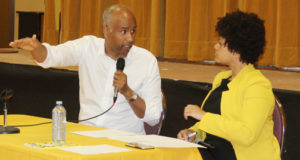
Immigration Minister says Liberal Government funding to Immigrant/Black community is historic.
The Minister for Immigration, Refugees and Citizenship, Ahmed Hussen, recently engaged with members of the public on the topics of changes to the Canadian immigration process, and funding to Black community development. Minister Hussen, speaking at the Jamaica Canadian Association, addressed concerns, and responded to questions from the audience. The following is an excerpt of that exchange.
Question: What has Government done to improve processing of refugee claims?
Minister Hussen: We talk about the importance of having people on different boards. The Immigration and Refugee Board has the most diverse group of people of any of the ministries, including members of the Black and Caribbean community. The IRB is processing more cases than ever before and that did not happen by accident, it happened because we funded it to do so. The IRB makes its own decisions based on the expertise of judges who are appointed professionals based on merit with the right backgrounds, the right diversity and the right representation. So he or she can appeal to the refugee appeal division.
Q: How has the point system changed to make entry into Canada easier?
A: So the questioner is talking about one of many immigration programs people can use to come to Canada especially in the skills economic streams. They’re talking about the express entry system. We have made changes to recognize that people have other skills that they bring to the table. We increased points for students from 30% to more than 50%. If you have family living in Canada, you now get more points automatically because we recognize that your integration into Canada will be easier. It’s also important to note that if somebody does not make the cut in Express entry immigration, there are other programs that they can apply to which we do not have as high points for qualification; the Rural Immigration Program, Temporary Foreign Workers program, the Agricultural and Meat Processing immigration category. Let’s also think about how many people are here year after year on a temporary basis.
For those who want to remain in Canada we should move them from temporary status to permanent residency and we are doing that in so many ways. So we’re eliminating the problem of family separation. Our economy needs 250,000 workers in Canada today, we need 50 000 truck drivers, today the meat cutting industry is short 12% of their workers right now. In some parts of Canada the need is even more severe as in Newfoundland and Labrador. Where are these people going to come from? The local supply is simply not enough so we need new immigrants for our future economic growth and to maintain the standard of living. So when someone comes to you with an anti-immigrant narrative they are against the national interest. They are actually working against your interest.
Q: What are the shared responsibilities of the provinces and how have you been working to improve that?
A: One of the hidden success stories of this Government has been what we have been able to do with immigration; 30% more families since 2015. That means the African Caribbean and Black Canadian organizations that suffered the brunt of the cuts under the Conservatives, are receiving increased funding. On top of that we have also introduced new settlement programs to get money for visible minorities such as racialized new-comer women to access the labour market. I wanted to make sure that money went to organizations who were quietly getting the hard work done in the community but never received funding before.
A part of our budget (2018-2019) has been historic due to the substantial funding dedicated to, and named funding for black Canadians. So substantial amounts of money has gone into anti-racism funding for research, newcomer workers, dedicated monies for black youth and for mental health. My concern is that if the community does not utilize those funds the argument will be made that we don’t need to provide this. I have teams of people who can walk you through the different pockets of money in the government but the community has to apply for it.
Q: What is Canada’s relationship like with Jamaica what does it look like on the ground?
A: Next to Haiti, Jamaica receives the largest amount of Canadian development assistance and is the only one of two countries in the Caribbean where Canada has a bilateral development program. It may require just a little bit of logistical assistance from Canada, so one of the things that we have now done is to establish an operation Center in Kingston at the Kingston airport to help Jamaica respond to natural disasters in the area; for example, when Dominica was devastated by a hurricane in 2017, it was the Jamaica Defence Force that responded. We have the heavy-lift aircraft so Canada is training Jamaicans to train other small states.
Jamaica is the launching pad for a $100 million fund to enable folks to be better prepared for hurricanes. When I was there I also saw the potential for Jamaica to benefit even more from the people to people ties with Canada. One of the disappointing things I noticed was at the official level or corporate level people were unaware of the facilitation that the Canadian government had done to welcome more workers, especially skilled trades workers. Let’s work together on this one.


